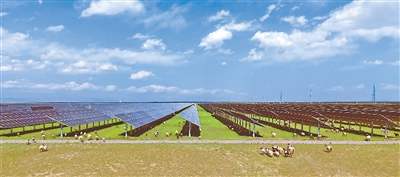




- BRNN
- BRI News
- BRNN News
- Database
Official Documents Polices and Regulations
Inter-government Documents International Cooperation BRI Countries
Business Guide Economic Data BRI Data
Trade
Investment Projects Latest projects
Cases - Content Pool

Sheep graze beneath solar panels at a photovoltaic park in the Talatan Gobi Desert in Gonghe county, Hainan Tibetan Autonomous Prefecture, northwest China's Qinghai Province. (People's Daily/Cao Jiwei)
By combining solar power generation with ecological restoration, agriculture, and animal husbandry, the Talatan Gobi Desert in Gonghe county, Hainan Tibetan Autonomous Prefecture, northwest China's Qinghai Province, which was once 98.5 percent desertified, has found a way to both combat desertification and boost incomes of locals.
Hainan Tibetan Autonomous Prefecture is rich in solar energy resources, and the Talatan Gobi Desert offers ideal conditions for developing solar and wind power. Huanghe Hydropower Development Co., Ltd., a subsidiary of the State Power Investment Corporation, began building a photovoltaic park in the Talatan Gobi Desert in 2011.
By the end of 2024, 68 photovoltaic companies had settled in the park, bringing total grid-connected capacity to 17.73 million kilowatts. This also had an unexpected upside — the ground beneath the solar panels carpeted with green grass.
This has greatly benefited locals like Li Qixiang of Xiahelesi village in Gonghe county. In the afternoon, he and other herders from the village took their sheep out to pasture in the photovoltaic park.
"The sun is blazing right now, so most of the sheep are sticking to the shade beneath the panels. There's enough grass here to last until the end of the year," Li said.
According to Li, his village relies on animal husbandry, with many residents raising sheep. In the past, the grass near the village wasn't enough due to desertification, so they had to drive their sheep to graze in more distant areas. But eventually, even those places began to run short on grass. As a result, they had to start giving the sheep extra feed at night, which pushed up their overall costs.
Chen Lihong, the first secretary of Xiahelesi village, said the villagers had experimented with many drought-resistant plants, but with little success. After the solar panels were installed, they helped block the wind and sand, and even played a role in stabilizing the soil.
"Solar power generation produces condensation, and the panels need to be cleaned regularly with water. At the same time, the shade from the panels cuts down evaporation from the ground. With more moisture in the soil and less wind, it's no surprise the grass has started to thrive," said Chen.
As the grass grew thick and lush, it once posed a challenge for the power station. Chen explained that if the grass grew too tall, it could block the solar panels and reduce power generation efficiency. In winter, the dry grass also became a potential fire hazard. Back then, companies in the park had to hire workers to clear it by hand.
In 2020, the village was among the first in the prefecture to combine animal husbandry with the development of the photovoltaic industry. Six ecological pastures were established within the park, where sheep grazed beneath the solar panels during the day and were herded back to the pastures at night.
"Nowadays, the park supports over 4,000 sheep," said Li, adding that the herders don't have to pay for grazing.
The photovoltaic park produces 118,000 tonnes of grass each year—enough to feed 200,000 sheep. Grazing on this grass, the sheep are of high quality and highly sought after in the market.
According to An Fengjun, director of the green industrial development park in Hainan Tibetan Autonomous Prefecture, the photovoltaic park has helped businesses cut costs and generated employment through various means. In 2024, new energy projects under construction created jobs for over 3,000 people, most of them nearby farmers and herders.
The transformation of the Talatan Gobi Desert offers valuable insights for Qinghai's desertification control. The prefecture's afforestation efforts in the photovoltaic park, including building windbreaks and planting trees, have raised vegetation coverage to over 80 percent.

Tel:86-10-65363107, 86-10-65368220, 86-10-65363106